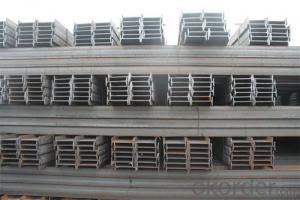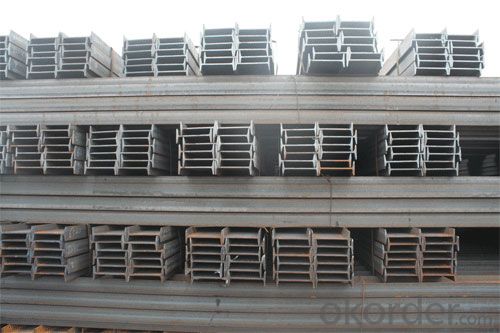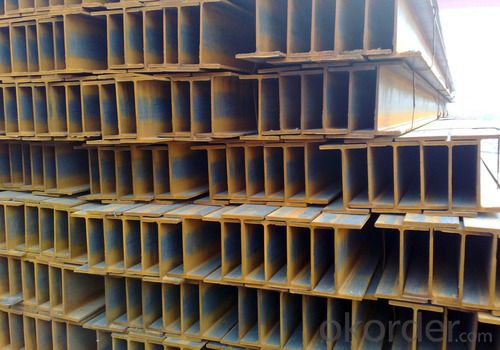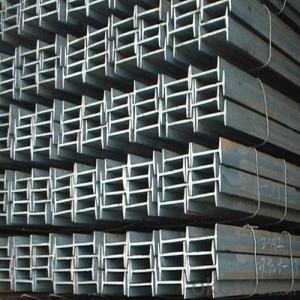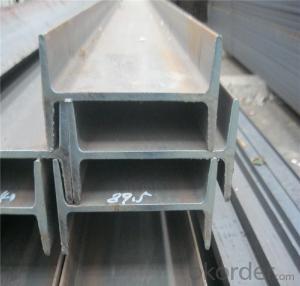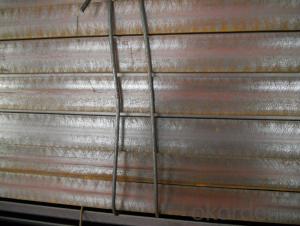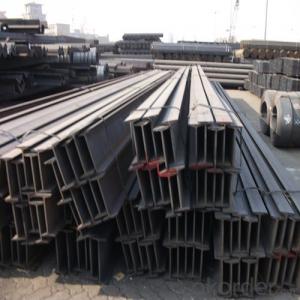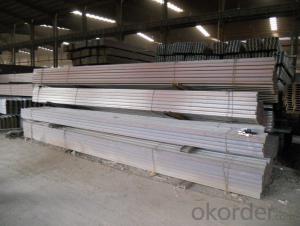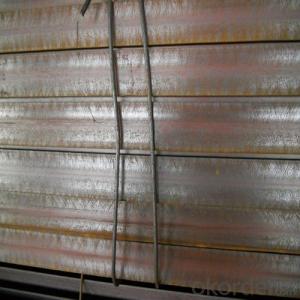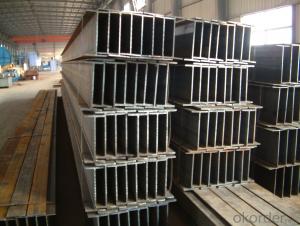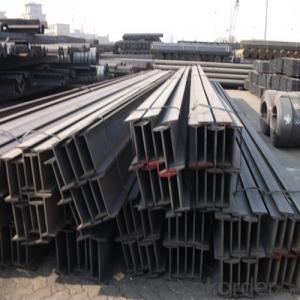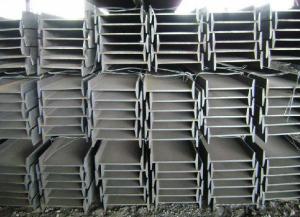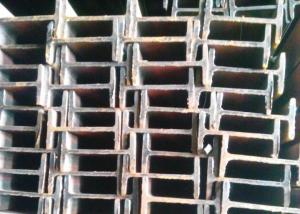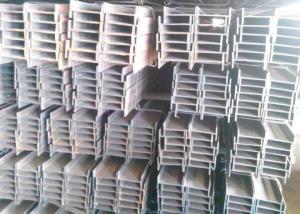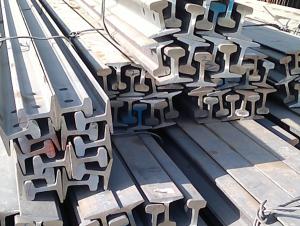High grade hot rolled H-section steel(Q235)
- Loading Port:
- Tianjin
- Payment Terms:
- TT OR LC
- Min Order Qty:
- 100 m.t.
- Supply Capability:
- 10000 m.t./month
OKorder Service Pledge
OKorder Financial Service
You Might Also Like
I-steel beam (also known as English name I Beam), is the section shape of strip steel i-beam.I-steel divides ordinary I-beam and light I-beam, H type steel three. Is the type of groove shaped steel section shape.
Introduction
I-steel beam (also known as English name I Beam), is an H-shaped steel section. I-steeldivides ordinary I-beam and light I-beam, H type steel three. The I-shaped steel is widely used in various building structures, bridges, vehicles, bracket, machinery etc..
I-beam
The reason of ordinary I-beam wing root and light I-beam to the edge of the progressively thinner, has a certain angle, the ordinary I-beam and light I-beam model is the Arabia digitalwith the waist high cm number to represent, web, flange thickness and width of flange to the different specifications to waist high (H) x width (leg b) * waist thickness (d) without number representation, such as "general 160 x 88 x 6", namely said waist high of 160 mm 88 mm in width, legs, waist thickness of 6 mm is ordinary i-beam. / "light 160 x 81 x 5", namely said waistheight 160 mm, width of 81 mm legs, light I-beam waist thickness is 5 mm. Ordinary I-beamspecifications are available models said, type representation of waist high cm, such asgeneral 16#. Waist high same I-steel, if there are several different wide legs and waist thick,need to add a B C to be the difference in the types of the right, such as general 32#a, 32#b,32#c etc.. Hot rolled ordinary I-beam specifications for 10-63#. Hot rolled ordinary I-beamspecifications of both sides of supply and demand supply for 12-55# protocol.
Ordinary steel
The basic difference
I-beam are divided into ordinary I-beam, light I-beam and H type steel three.
Ordinary I-beam, light I-beam flanges on the web is variable cross section of thick, outer thin;H type steel: HW HM HN HEA HEB flange HEM I-beam is uniform
Ordinary I-beam, light I-beam has formed the national standard, the common 10# I-beamequivalent to the international I100 (such as the 10# channel also equivalent to channel(U100) for countries to implement different standards, resulting in subtle differences in their specifications)
H sections are also called the wide flange steel, HW HM HN derived from the European standard, HEB is the German standard I-beam, where HW, HN I-steel has been widely used in our country and production. HEA HEB HEM seen in many German design will, in the domestic market is also very difficult to buy. In the domestic steel structure engineering, if less, you can use the other specifications of steel plate welding assembled. And a large quantity of words,usually consider the use of mechanical properties and equivalent HW, HN type steel instead of.
HW I-beam is mainly used for reinforced concrete frame column steel column, also known asreinforced steel column; in the steel structure is mainly used for the column
HM type steel height and width of flange is roughly 1.33~~1.75 used for steel frame columnsin frame structure under dynamic load is used for the main frame beam in steel structure; for example: equipment platform
HN type steel height and flange width ratio is greater than or equal to 2; mainly used for beam
Use ordinary I-beam equivalent to HN steel;
The I-shaped steel whether ordinary or light, because the section size are relatively high,narrow, so the moment of inertia of the cross-section of two spindle difference, therefore, can only be used directly in the web plane bending component or its component lattice stress components. The axial compression member or in the perpendicular to the web plane and curved components are not used, thus in their application range is limited.
The H steel is efficient and economic cutting surface profile (there are other cold-formed steel, steel etc.), owing to the section shape is reasonable, they can make the steel higher effectiveness, improve the bearing capacity. Different from the ordinary I-shaped flange type H steel was widened, and the internal and external surface is usually parallel, which can facilitate the connection with high strength bolts and other components. Its size to form a series of reasonable, model complete, easy to use design.
The scope of application
Ordinary I-beam, light I-beam, because the section size are relatively high, narrow, so themoment of inertia of the cross-section of two main sleeve difference, thus in their applicationrange is limited. The I-steel should be based on the requirements of design drawings for choice.
The size design
H steel is efficient and economic cutting surface of steel (there are other cold-formed steel,steel etc.), owing to the section shape is reasonable, they can make the steel higher effectiveness, improve load ability. Different from the ordinary I-beam is flange type H steelwas widened, and the inner and the outer surface is usually parallel, which can facilitate theconnection with high strength bolts and other components. The composition of a reasonablesize, model complete, easy to use design.
In structure design, selection of I-beam should be based on its mechanical properties,chemical properties, weldability, structure size and the reasonable choice of the I-beam touse.
Welding process
Flange type H steel are of equal thickness, a rolling section, there are composite section is composed of 3 blocks of plate welding composition. Ordinary I-beam are rolling section,because of the production process is poor, the flange edge 1:10 slope. H type steel rolling is different from ordinary I-beam with only one set of horizontal roll, because of its wide flangeand no inclination (or slope is very small), so it will be a group of vertical roll at the same timerolling, therefore, the rolling technology and equipment than the conventional mill complex.The maximum rolling H steel of domestic production can be the height of 800mm, more thanonly welding composite section.
- Q: How do steel I-beams perform in terms of sound insulation?
- Steel I-beams do not perform well in terms of sound insulation. Due to their rigid structure and lack of sound-absorbing materials, steel I-beams tend to transmit sound vibrations rather than absorb or block them, making them poor for sound insulation purposes.
- Q: What are the different types of steel connections used for I-beams in renovations?
- There exist various steel connections commonly utilized in renovation projects for I-beams. These connections serve to provide structural support and stability to the I-beams, ensuring their ability to bear weight and loads effectively. One frequently used steel connection in renovations is the bolted connection. This involves the utilization of bolts and nuts to secure the I-beam to other structural elements like columns, beams, or plates. Bolted connections possess great versatility and can be easily adjusted or modified if necessary. They offer a strong and reliable connection, making them suitable for a wide range of renovation endeavors. Another type of steel connection is the welded connection. This entails welding the I-beam to other steel components, resulting in a permanent and seamless joint. Welded connections exhibit excellent strength and rigidity, making them ideal for heavy-duty applications. However, it is crucial to employ proper welding techniques to maintain the connection's integrity. Additionally, specialized steel connections are available for specific renovation scenarios. For instance, moment connections are utilized to resist rotational forces or moments. These connections are designed to provide additional rigidity and stability to the I-beams, preventing undesired movement or deflection. Moreover, eccentric connections are used when the center of gravity of the I-beam does not align perfectly with the connecting element. These connections are designed to accommodate this eccentricity and ensure a secure and stable connection. Ultimately, the choice of steel connection for I-beams in renovations depends on factors such as load requirements, structural design, and specific project constraints. Consulting with a structural engineer or construction professional is essential to determine the most suitable steel connection type for a particular renovation project.
- Q: What are the different load configurations that Steel I-Beams can support?
- Steel I-beams can support various load configurations due to their structural strength and versatility. Some of the different load configurations that steel I-beams can support include: 1. Uniformly Distributed Load (UDL): This is a load that is evenly distributed over the length of the beam. It is one of the most common load configurations and is often applied in structures such as floors, roofs, and bridges. 2. Point Load: Also known as a concentrated load, this configuration involves a single load applied at a specific point on the beam. Point loads are commonly found in structures where heavy machinery or equipment is placed, such as in industrial buildings. 3. Cantilever Load: In this configuration, the load is applied at the end of the beam and extends beyond its support. Cantilever loads are often encountered in structures like balconies, canopies, and overhanging beams. 4. Distributed Load: Unlike a uniformly distributed load, a distributed load is not evenly spread over the entire length of the beam. Instead, it is distributed in a non-uniform manner. This load configuration is commonly seen in structures with varying load intensities, such as storage racks or shelving systems. 5. Dynamic Load: Dynamic loads are loads that vary over time, such as moving vehicles or machinery. Steel I-beams are capable of supporting dynamic loads as they have excellent resistance to fatigue and can withstand repeated stress cycles. 6. Wind Load: Steel I-beams are often used in the construction of tall buildings and structures that are exposed to high wind speeds. They can effectively support wind loads by transferring the forces to the building's foundations. 7. Snow Load: In regions with heavy snowfall, steel I-beams are designed to support the weight of accumulated snow on roofs and other horizontal structures. The beam's load capacity is determined based on the anticipated snow accumulation in the area. It is important to note that the load configurations supported by steel I-beams are dependent on factors such as the beam's size, shape, material properties, and the specific design requirements of the structure. Consulting with a structural engineer or a professional in the field is crucial to ensure the appropriate load configurations are considered and properly accounted for in the design and construction process.
- Q: Are Steel I-Beams suitable for high-rise buildings?
- Yes, steel I-beams are highly suitable for high-rise buildings. Steel I-beams offer several advantages that make them the preferred choice for constructing tall buildings. Firstly, steel I-beams possess exceptional strength and durability. These beams are designed to withstand heavy loads and provide structural integrity, making them ideal for supporting the weight of multiple floors and handling the lateral forces experienced in high-rise buildings. Moreover, steel I-beams have a high strength-to-weight ratio, meaning they can support large loads without being excessively heavy themselves. This characteristic allows for the construction of taller buildings as the weight of the structural elements is minimized, resulting in more efficient designs and reduced costs. Additionally, steel I-beams offer flexibility in design. They can be fabricated to various lengths, widths, and depths, enabling architects and engineers to create innovative and unique structures. This adaptability allows for the optimization of space and design aesthetics in high-rise buildings. Furthermore, steel I-beams are fire-resistant, providing a higher level of safety compared to other building materials. Steel does not burn, melt, or contribute to the spread of fire, which is crucial in tall buildings where fire safety is of utmost importance. Lastly, steel I-beams are sustainable and environmentally friendly. Steel is a recyclable material, which means that at the end of their lifespan, the beams can be reused or repurposed rather than ending up in landfills. This sustainability aspect is crucial for high-rise buildings, which often strive to achieve green building certifications. Overall, steel I-beams are an excellent choice for high-rise buildings due to their strength, durability, flexibility, fire-resistance, and sustainability. They provide the necessary structural support, allow for innovative designs, and prioritize safety – making them a highly suitable option for constructing tall buildings.
- Q: How are steel I-beams installed during construction?
- Steel I-beams are typically installed during construction by first preparing the foundation or structural supports. The I-beams are then lifted into place using cranes or other heavy machinery. They are aligned and secured to the supports using bolts or welding. Additional components, such as columns or cross braces, may be added to enhance stability and structural integrity.
- Q: What are the considerations for steel I-beam design in high-traffic areas?
- When designing steel I-beams for high-traffic areas, several considerations need to be taken into account to ensure the structural integrity and safety of the construction. 1. Load-bearing capacity: High-traffic areas are subjected to heavy loads, such as vehicles or heavy machinery. The I-beam design should be able to withstand these loads without excessive deflection or failure. Engineers need to calculate the maximum load that the I-beam will experience and design it accordingly, considering both static and dynamic loads. 2. Material selection: The choice of steel grade is crucial in high-traffic areas. High-strength steels, such as ASTM A992 or A572, are commonly used due to their excellent strength-to-weight ratio. These steels offer higher yield and tensile strength, ensuring the beam can support heavy loads and resist fatigue. 3. Span length and support considerations: The distance between supports, or span length, is an important factor to consider. Longer spans may require larger and heavier I-beams to prevent excessive deflection. The type and arrangement of supports, such as columns or beams, should be carefully designed to distribute the load evenly and avoid concentrated stress points. 4. Vibration control: High-traffic areas often experience vibrations due to moving vehicles or machinery. Vibrations can affect the structural integrity of the I-beam, leading to fatigue failure over time. Engineers may need to incorporate vibration dampening techniques, such as adding dampers or isolators, to mitigate the impact of vibrations on the steel I-beam. 5. Fire resistance: In high-traffic areas, fire safety is crucial. Steel I-beams can be designed to have fire resistance by applying fireproof coatings or encasing them in fireproof materials. The design should also consider the fire protection measures in place, such as fire sprinkler systems, to ensure the I-beams can withstand the elevated temperatures during a fire. 6. Corrosion protection: High-traffic areas are often exposed to harsh environmental conditions, including moisture or chemicals. Corrosion protection measures, such as galvanization or epoxy coatings, should be implemented to prevent rust and corrosion, which can weaken the steel I-beam over time. 7. Accessibility and maintenance: Considerations should be made for accessibility and maintenance of the steel I-beam. High-traffic areas may require regular inspections and maintenance. Access points, such as walkways or platforms, should be incorporated into the design to facilitate inspections and repairs without disrupting the traffic flow. By carefully considering these factors, engineers can design steel I-beams that can safely withstand the demands of high-traffic areas, ensuring the longevity and reliability of the structure.
- Q: How do steel I-beams perform in terms of electromagnetic interference (EMI) shielding?
- Steel I-beams are not effective in terms of electromagnetic interference (EMI) shielding. Steel is a good conductor of electricity, which means it can actually amplify electromagnetic interference rather than shielding it. To effectively shield against EMI, materials with high magnetic permeability, such as mu-metal or certain alloys, are typically used.
- Q: How do you calculate the shear deflection due to axial load in a steel I-beam?
- In order to calculate the shear deflection caused by axial load in a steel I-beam, one must take into account the beam's geometry, material properties, and the load being applied. The following steps outline the process of performing this calculation: 1. Initially, one must determine the cross-sectional properties of the I-beam, including the moment of inertia (I) and the area (A). These values can be acquired from the manufacturer's specifications or by directly measuring the dimensions of the beam. 2. The modulus of elasticity (E) for the steel material used in the I-beam needs to be determined. This value reflects the material's stiffness and can also be obtained from manufacturer data or engineering resources. 3. The shear force (V) acting on the beam due to the axial load must be calculated. This can be achieved by employing statics equations or analyzing the load distribution along the beam. 4. The next step involves using the formula for shear deflection in a beam to compute the deflection (δ). The formula is as follows: δ = (V * L^3) / (3 * E * I), where L denotes the length of the beam. 5. It is necessary to substitute the known values into the formula and solve for δ. It is important to maintain consistent units throughout the calculation. 6. The resulting value of δ signifies the shear deflection caused by the axial load in the given steel I-beam. This value indicates the amount of vertical displacement the beam will experience under the applied load. It should be noted that this calculation assumes linear behavior and disregards other factors such as shear deformation and bending effects. For more accurate results, advanced analysis methods or finite element analysis (FEA) software can be utilized.
- Q: How do steel I-beams contribute to the overall stability of a building?
- There are multiple ways in which steel I-beams enhance the stability of a building. First and foremost, I-beams are well-known for their remarkable strength and ability to bear heavy loads. Their distinctive shape allows for an even distribution of weight, minimizing the risk of structural failure. The vertical web of the I-beam offers maximum resistance against bending and buckling, enabling it to support heavy loads and withstand external forces like wind or seismic activity. Additionally, the utilization of steel I-beams in construction permits the creation of longer spans and larger open spaces within a building. This is because I-beams have the capacity to support larger loads without requiring additional columns or supports. The ability to have larger uninterrupted floor areas enhances the building's flexibility and functionality, accommodating different uses and allowing for various design possibilities. Furthermore, steel I-beams contribute to the overall stability of a building by providing structural rigidity. The inherent stiffness of steel, combined with the efficient design of the I-beam, helps to minimize deflection and sway in the building during dynamic events such as strong winds or earthquakes. This guarantees that the building remains stable and can withstand external forces without compromising its structural integrity. Moreover, steel I-beams are highly durable and resistant to corrosion, making them particularly important in areas with high humidity or exposure to harsh weather conditions. This durability ensures that the building's structural elements remain intact over time, reducing the risk of deterioration and ensuring long-term stability. In conclusion, steel I-beams contribute to the overall stability of a building through their exceptional strength, load-bearing capacity, and resistance to bending and buckling. They provide structural rigidity, allow for larger open spaces, and offer durability against corrosion. By incorporating steel I-beams into the construction process, buildings can achieve enhanced stability, safety, and longevity.
- Q: Why are the rails made of I-beam?
- The type and strength of the rail are represented by kg/m. The heavier the rail, the greater the weight it can bear.
Send your message to us
High grade hot rolled H-section steel(Q235)
- Loading Port:
- Tianjin
- Payment Terms:
- TT OR LC
- Min Order Qty:
- 100 m.t.
- Supply Capability:
- 10000 m.t./month
OKorder Service Pledge
OKorder Financial Service
Similar products
Hot products
Hot Searches
Related keywords
